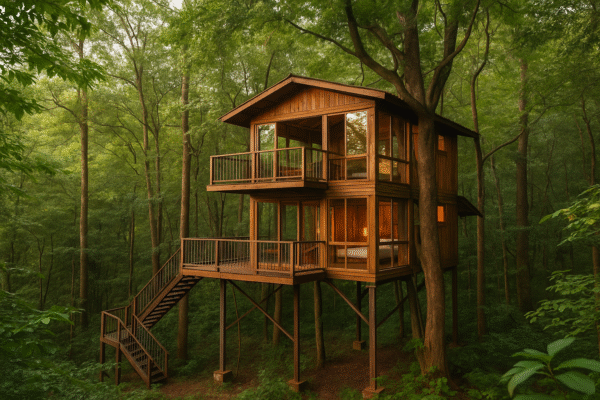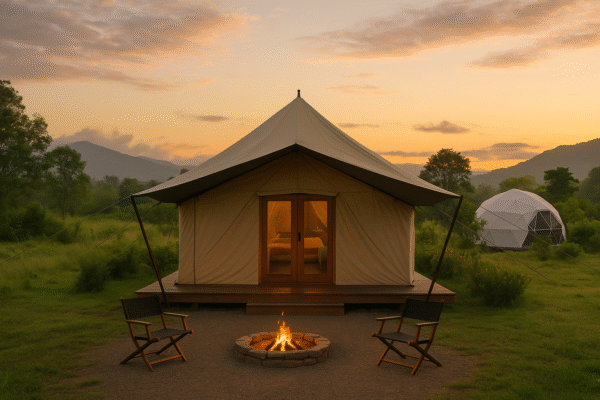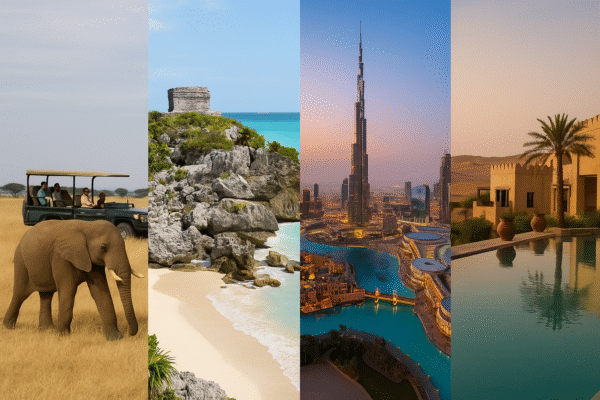Glamping Goes Global: How Luxury Camping Is Reshaping Sustainable Tourism in India and Beyond
As post-pandemic travelers reject overcrowded resorts and bland hotel rooms, a quieter revolution is taking place—from the forests of Satpura to the snowcaps of the Swiss Alps. It’s called glamping, and it’s redefining how the world experiences nature.
Once a fringe concept limited to safari-style luxury tents for high-end adventurers, glamping has matured into a billion-dollar global industry. Short for “glamorous camping,” glamping blends rustic settings with upscale amenities: think treehouses with air conditioning, geodesic domes with plush beds, or beachfront canvas villas with private chefs. Today, from Rajasthan’s Jawai Leopard Reserve to Canada’s indigenous-led forest retreats, glamping is at the heart of sustainable tourism and cultural engagement.
Why Glamping, Why Now?
The global boom in glamping intersects three dominant travel trends:
- the experience economy,
- the rise of eco-conscious tourism,
- and a demand for authentic, local experiences.
According to India’s Ministry of Tourism and global hospitality industry reports, post-COVID preferences have shifted dramatically toward low-impact, immersive, and private travel—the very qualities glamping naturally delivers. Travelers no longer need to choose between roughing it in the wild or isolating in luxury hotels. With glamping, they get the best of both worlds.
India’s Glamping Movement: Nature Meets Culture
India is fast becoming a glamping hotspot. The country’s diverse ecosystems—deserts, mountains, mangroves, and beaches—offer rich potential for luxury outdoor stays:
- Jawai, Rajasthan: Leopard spotting by day and luxury tents under star-lit skies by night.
- Rishikesh, Uttarakhand: Yoga by the Ganges and chic riverfront glampsites.
- Wayanad, Kerala: Romantic forest escapes with minimal ecological footprints.
- Satpura, Madhya Pradesh: Tiger reserves meet safari-style glamping with expert-led jungle trails.
- Kodagu (Coorg), Karnataka: Western Ghats meets hill-top canopy tents.
- Chilika & Daringbadi, Odisha: Beach and forest retreats integrated into tribal villages.
- Sundarbans, West Bengal: Mangrove safaris with local folklore and sustainable fishing experiences.
Supported by the National Strategy for Sustainable Tourism (2022), the Indian government has recognized glamping as a tool for rural development, employment generation, and environmental preservation. Odisha’s Eco Retreat Odisha has already earned accolades for setting up glamping pods in underexplored areas—successfully marrying tourism with conservation.
Global Wave: From Pakistan to the Swiss Alps
India isn’t alone. Glamping is reshaping tourism economies across continents:
- Khyber Pakhtunkhwa, Pakistan: Sustainable national park initiatives promote eco-glamping to preserve fragile mountain ecosystems.
- British Columbia, Canada: Indigenous-led glamping lodges offer immersive cultural learning and land stewardship programs.
- Utah & Tennessee, USA: State-led park expansions include glamping zones that reduce overcrowding in national parks like Zion and Bryce Canyon.
- Costa Rica & Swiss Alps: Profits from glamping stays directly support reforestation and carbon offset projects.
These models underscore that glamping is not a copy-paste hospitality solution—it’s culturally and ecologically adaptable, making it suitable for both Himalayan villages and coastal American reserves.
Economic and Social Impact
Glamping’s return on investment is far greater than traditional hotels. According to Indian tourism boards, a single glamping unit can generate four to six times the local revenue of a hotel room, due to longer stays, curated local activities, and minimal leakages to multinational chains.
In Odisha, nearly 70% of the glamping workforce comes from tribal and rural communities. Locals are trained in hospitality, carpentry, guiding, and horticulture, building livelihoods beyond seasonal tourism. Artisans are now being commissioned to create eco-friendly decor and furnishings, reviving traditional crafts in the process.
Glamping for the Planet
Glamping also aligns closely with environmental conservation. Many sites operate with zero-concrete policies, solar power, composting toilets, and locally sourced materials. In Satpura and Wayanad, partnerships between forest departments and private operators ensure adherence to strict carrying capacity guidelines.
Even in the U.S., National Park Services now monitor glamping impacts on flora, fauna, and water systems, ensuring that nature remains the star of the show.
Digital Booking, Youth Appeal, and Inclusivity
The rise of glamping also correlates with changing demographics. Millennials and Gen Z are the largest travel spenders and prioritize eco-consciousness, privacy, and shareability. Platforms like Airbnb and dedicated glamping websites have democratized access, while Indian government tourism sites now certify and promote eco-glampsites nationwide.
Culture in Canvas
Glamping is more than a luxury stay—it’s an invitation to cultural immersion. In Rajasthan, guests engage in block-printing workshops and folk music nights. In the Sundarbans, tea on stilts comes with stories of Bonbibi, the guardian of the forest.
Governments increasingly view glamping as soft diplomacy—a method to showcase heritage while avoiding the ecological burdens of mass tourism.
Proceed With Caution: Planning Is Key
While the benefits of glamping are clear, so are the risks of overdevelopment. The 2024 Wayanad landslides were a wake-up call—caused in part by unregulated construction. Experts now push for zoning laws, waste management systems, and environmental audits to prevent glamping from repeating the mistakes of unchecked tourism.
A New Era Under the Stars
From Paris to Rishikesh, Bali to British Columbia, glamping is changing how and why we travel. It’s a delicate blend of comfort, conservation, and culture that doesn’t just offer a holiday—it offers a vision for a better future in tourism.
In a world searching for meaningful, mindful escapes, glamping is no longer a luxury. It’s a necessity—for travelers, for local communities, and for the planet.
For more travel news like this, keep reading Global Travel Wire






















